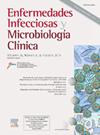结核感染患者血清25-羟基维生素D3与氧化平衡评分的相关性
IF 2.5
4区 医学
Q3 INFECTIOUS DISEASES
Enfermedades infecciosas y microbiologia clinica
Pub Date : 2025-05-01
DOI:10.1016/j.eimc.2024.09.012
引用次数: 0
摘要
背景以往的研究报道了结核(TB)中促氧化剂和抗氧化剂的失衡,这与结核病的发展有关。本研究旨在确定与结核感染患者氧化平衡相关的关键氧化应激指标。方法共纳入339例结核病患者。氧化平衡评分(OBS)由饮食和生活方式因素评分组成。采用趋势回归分析、广义加性模型、多项式回归分析和阈值效应分析,探讨血清25-羟基维生素D3 25(OH)D3与OBS的关系。此外,通过Pearson分析探讨血清25(OH)D3与OBS成分的相关性,并通过中介分析探讨OBS成分的作用。结果线性回归分析显示,6项氧化应激指标中,血清25(OH)D3与OBS独立相关。然后发现两者之间呈正相关(P代表趋势<;0.05)呈非线性关系(均P <;0.05)。通过阈值效应分析,25(OH)D3浓度为51.9 nmol/L时为关键转折点,只有当25(OH)D3浓度为51.9 nmol/L时,两者才存在关联。此外,我们发现25(OH)D3主要与BMI和核黄素两种OBS成分相关。此外,通过中介分析发现BMI和核黄素介导了血清25(OH)D3与OBS的关联(均P <;0.05)。结论本研究揭示了结核病患者血清25(OH)D3与OBS的关系,为维生素D辅助治疗结核病提供了证据。本文章由计算机程序翻译,如有差异,请以英文原文为准。
The correlation between serum 25-hydroxyvitamin D3 and oxidative balance score in patients with tuberculosis infection
Background
Previous study had reported the imbalance of pro- and anti-oxidants in tuberculosis (TB), which was involved in the TB progression. This study aimed to identify the key oxidative stress indicator associated with oxidative balance in patients with TB infection.
Methods
Overall, 339 participants with TB were included in this study. The oxidative balance score (OBS) was composed of scores of dietary and lifestyle factors. Trend regression analysis, generalized additive model, polynomial regression, and threshold effect analysis, were used to examine the relationship between the serum 25-hydroxyvitamin D3 25(OH)D3 and OBS. Moreover, the correlation between serum 25(OH)D3 and OBS components was explored via Pearson analysis, and mediation analysis was used to explore the function of OBS components.
Results
Linear regression analysis showed that among 6 oxidative stress indicators, only serum 25(OH)D3 was independently related to the OBS. A positive association between them was then found (P for trend < 0.05) in a non-linear relationship (all P < 0.05). The 25(OH)D3 concentration of 51.9 nmol/L was identified as the key turning point by threshold effect analysis, and their association was only found when it <51.9 nmol/L. Further, we revealed that 25(OH)D3 mainly correlated with 2 OBS components including BMI and riboflavin. Moreover, BMI and riboflavin were found to mediate the association of serum 25(OH)D3 with OBS by mediation analysis (all P < 0.05).
Conclusions
In summary, our study revealed relationship between the serum 25(OH)D3 and OBS in patients with TB, which provided a piece of evidence that vitamin D can assist the treatment of TB.
求助全文
通过发布文献求助,成功后即可免费获取论文全文。
去求助
来源期刊
CiteScore
2.10
自引率
8.00%
发文量
194
审稿时长
29 days
期刊介绍:
Hoy está universalmente reconocida la renovada y creciente importancia de la patología infecciosa: aparición de nuevos agentes patógenos, de cepas resistentes, de procesos con expresión clínica hasta ahora desconocida, de cuadros de una gran complejidad. Paralelamente, la Microbiología y la Infectología Clínicas han experimentado un gran desarrollo como respuesta al reto planteado por la actual patología infecciosa. Enfermedades Infecciosas y Microbiología Clínica es la Publicación Oficial de la Sociedad Española SEIMC. Cumple con la garantía científica de esta Sociedad, la doble función de difundir trabajos de investigación, tanto clínicos como microbiológicos, referidos a la patología infecciosa, y contribuye a la formación continuada de los interesados en aquella patología mediante artículos orientados a ese fin y elaborados por autores de la mayor calificación invitados por la revista.

 求助内容:
求助内容: 应助结果提醒方式:
应助结果提醒方式:


